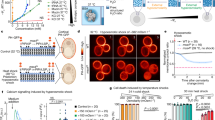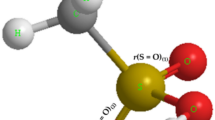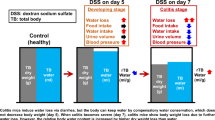Abstract
IT is well established1 that the structure of water in the vicinity of any surface is different from that of bulk water; also, nuclear magnetic resonance and dielectric relaxation studies have shown that, both in vitro and in vivo, the water adjacent to proteins and other macromolecules is oriented and its motional freedom is impeded2–6. Furthermore, water exerts a significant stabilizing effect on the structure of some macromolecules7–9. But there is still considerable debate10–16 concerning (1) the ability of the water of hydration of intracellular proteins to participate in osmotic changes occurring when cells are placed in hyper or hypotonic solution, and (2) the amount of osmotically inactive water in cells in normal physiological conditions. I wish to report a change in the space accessible to dimethyl sulphoxide in isolated guinea-pig intestinal smooth muscle induced by cooling the muscle from +37° C to −7° C in the absence of ice crystal formation. Dimethyl sulphoxide (DMSO) is a polar, water-miscible non-electrolyte which can form hydrogen bonds only by accepting hydrogen (by contrast, water is an acceptor and donor of hydrogen bonds). The kinetics of permeation of DMSO in smooth muscle have been studied previously17 and this non-electrolyte has been used with some success in preventing damage to smooth muscle exposed to sub-zero temperatures18,19.
This is a preview of subscription content, access via your institution
Access options
Subscribe to this journal
Receive 51 print issues and online access
$199.00 per year
only $3.90 per issue
Buy this article
- Purchase on SpringerLink
- Instant access to full article PDF
Prices may be subject to local taxes which are calculated during checkout
Similar content being viewed by others
References
Bernal, J. D., Symp. Soc. Exp. Biol., 19, 17 (1965).
Kuntz, jun., I. D., Brassfield, T. S., Law, G. D., and Purcell, G. V., Science, 163, 1329 (1969).
Cope, F. W., Biophys. J., 9, 303 (1969).
Hazlewood, C. F., Nichols, B. L., and Chamberlain, N. F., Nature, 222, 747 (1969).
Masuzawa, M., and Sterling, C., Biopolymers, 6, 1453 (1968).
Gent, W. L. G., Grant, E. H., and Tucker, S. W., Biopolymers, 9, 124 (1970).
Tunis, M-J. B., and Hearst, J. E., Biopolymers, 6, 1325 (1968).
Ramachandran, G. N., and Chandrasekharan, R., Biopolymers, 6, 1649 (1968).
Privalov, P. L., and Tiktopulo, E. I., Biopolymers, 9, 127 (1970).
Overton, E., Pflügers Arch. Ges. Physiol., 92, 115 (1902).
Hill, A. V., Proc. Roy. Soc., B, 106, 477 (1930).
Dick, D. A. T., Cell Water (Butterworths, London, 1966).
Gary-Bobo, C. M., J. Gen. Physiol., 50, 2547 (1967).
Cook, J. S., J. Gen. Physiol., 50, 1311 (1967).
Gary-Bobo, C. M., and Solomon, A. K., J. Gen. Physiol., 52, 825 (1968).
McLaughlin, S. G. A., and Hinke, J. A. M., Canad. J. Physiol. Pharmacol., 44, 837 (1966).
Elford, B. C., J. Physiol. (in the press).
Farrant, J., Nature, 205, 1284 (1965).
Elford, B. C., Cryobiology (in the press).
Farrant, J., J. Pharm. Pharmacol., 16, 472 (1964).
Brading, A. F., and Setekleiv, J., J. Physiol., 195, 107 (1968).
Ponder, E., Haemolysis and Related Phenomena (Churchill, London, 1948).
Ling, G. N., A Physical Theory of the Living State: The Association-Induction Hypothesis (Blaisdell, New York, 1962).
Troshin, W. M., Problems of Cell Permeability (Pergamon Press, Oxford, 1966).
Jones, A. W., in Smooth Muscle (edit. by Bülbring, E., Brading, A., Jones, A., and Tomita, T.), (Edward Arnold, London, 1970).
Brandts, J. F., Fu, J., and Nordin, J. H., in The Frozen Cell, Ciba Foundation Symp. (edit. by Wolstenholme, G. E. W., and O'Connor, M.) (Churchill, London, 1970).
Rubner, M., Abh. Preuss. Akad. Wiss., 1, 1 (1922).
Goodford, P. J., in Smooth Muscle (edit. by Bülbring, E., Brading, A., Jones, A., and Tomita, T.) (Edward Arnold, London, 1970).
Edsall, J. T., in The Proteins, 1, part B (edit. by Neurath, H., and Bailey, K.) (Academic Press, New York, 1953).
Mazur, P., J. Gen. Physiol. ., 47, 347 (1963).
Moore, R., Davids, N., and Friedenberg, R., Currents in Modern Biology, 3, 156 (1969).
Farrant, J., and Woolgar, A. E., in The Frozen Cell, Ciba Foundation Symp. (edit. by Wolstenholme, G. E. W., and O'Connor, M.) (Churchill, London, 1970).
Dick, D. A. T., Intern. Rev. Cytol., 8, 387 (1959).
Author information
Authors and Affiliations
Rights and permissions
About this article
Cite this article
ELFORD, B. Non-solvent Water in Muscle. Nature 227, 282–283 (1970). https://doi.org/10.1038/227282a0
Received:
Issue date:
DOI: https://doi.org/10.1038/227282a0
This article is cited by
-
Preservation of Structure and Function of Smooth Muscle cooled to −79° C in Unfrozen Aqueous Media
Nature New Biology (1972)



